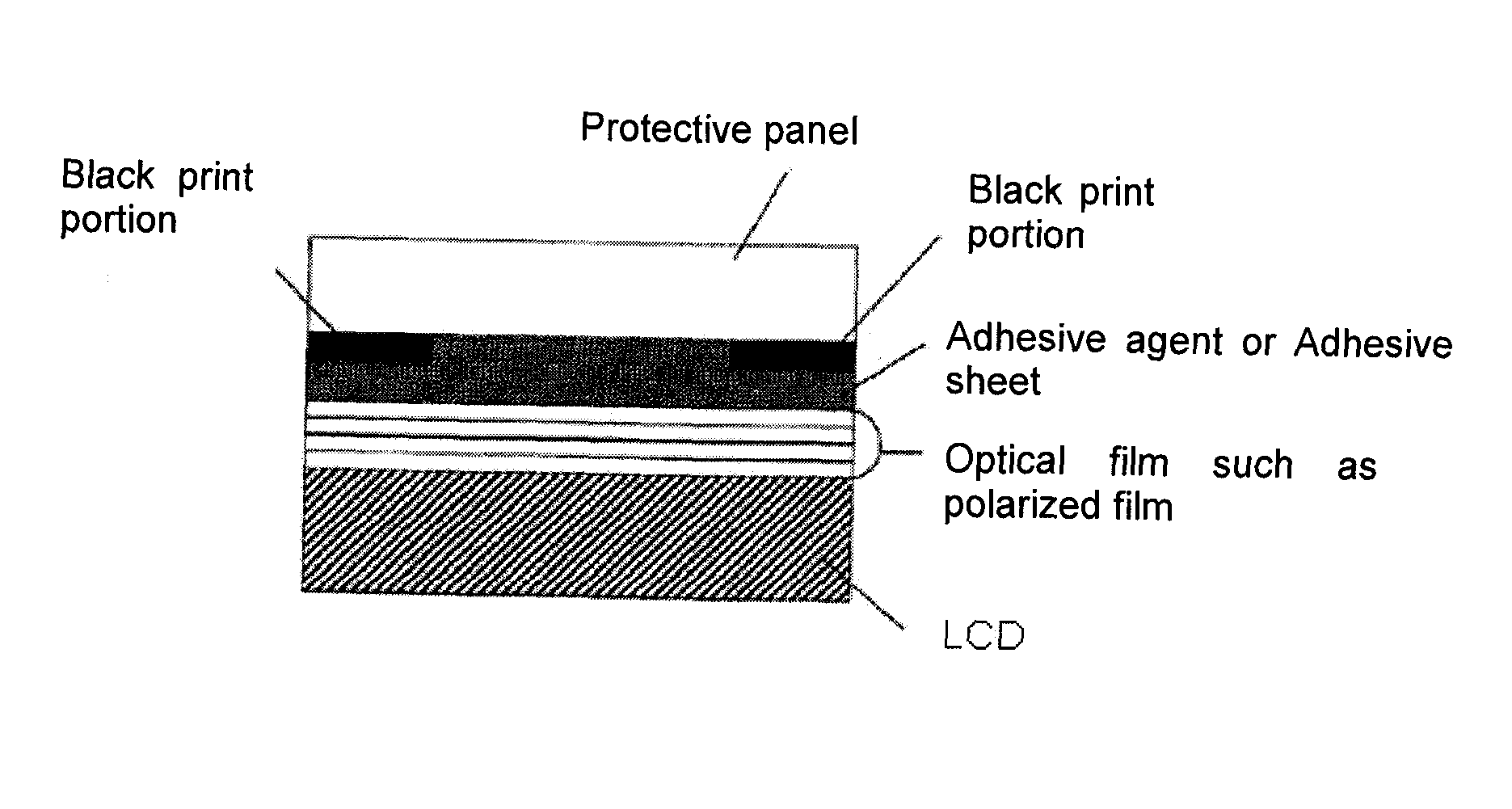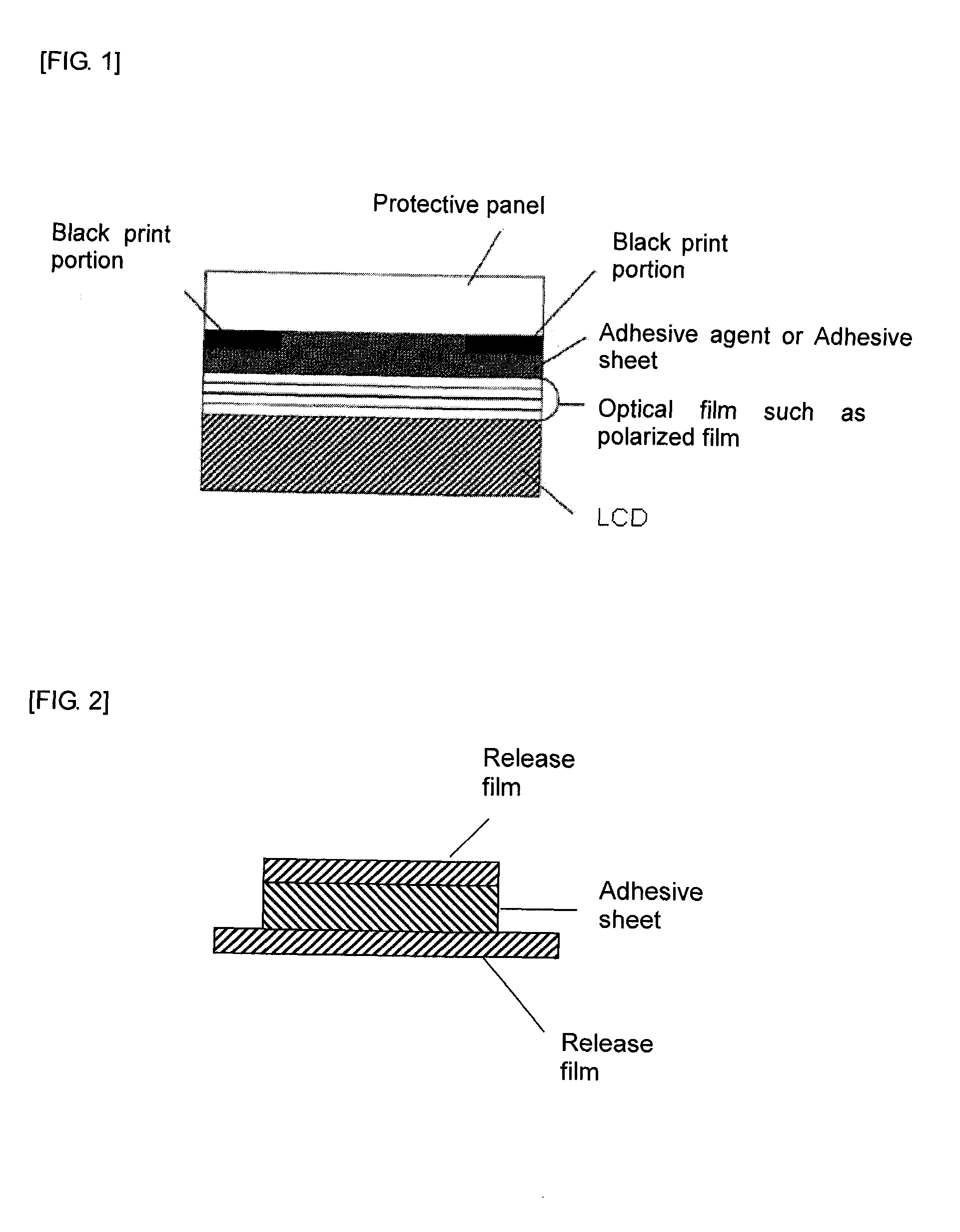Transparent adhesive sheet and image display device
a technology of transparent adhesives and adhesive sheets, applied in the direction of film/foil adhesives without carriers, film/foil adhesives, instruments, etc., can solve the problems of reducing image visibility, difficult to realize a thin body, and reducing screen visibility
- Summary
- Abstract
- Description
- Claims
- Application Information
AI Technical Summary
Benefits of technology
Problems solved by technology
Method used
Image
Examples
example 1
Preparation of First Adhesive Layer-Attached Sheet
[0152]2.0 Weight parts of a photo initiator (trademark: Ezacure TZT, manufactured by Nihon SiberHegner) and 20 weight parts of a cross-linking agent (tetrafunctional acrylate (trademark: NK ester ATM-4PL, manufactured by Shin Nakamura Chemical, Co. Ltd.)) with respect to 100 weight parts of previously polymerized acrylic acid ester copolymer A were melt with stirring and uniformly mixed to prepare an adhesive agent composition.
[0153]This adhesive agent composition was applied to the release surface of a silicone-coated release PET film (trademark: MRF 50, manufactured by MITSUBISHI POLYESTER FILM CORPORATION) having a thickness of 50 μm with use of a hot-melt coater and then the silicone-coated release PET film was overlapped with another silicone-coated release PET film (trademark: MRF 50, manufactured by MITSUBISHI POLYESTER FILM CORPORATION) so that the adhesive agent composition was interposed between the two silicone-coated rele...
example 2
Preparation of First Adhesive Layer-Attached Sheet
[0161]The first adhesive layer-attached sheet used in Example 1 was used as the first adhesive layer-attached sheet in Example 2.
[0162](Preparation of Second Adhesive Layer-Attached Sheet)
[0163]2.0 weight parts of a photo initiator (trademark: Ezacure TZT, manufactured by Nihon SiberHegner) and 5 weight parts of a cross-linking agent (trifunctional acrylate (trademark: Viscoat V295, manufactured by OSAKA ORGANIC CHEMICAL INDUSTRY LTD.)) with respect to 100 weight parts of previously polymerized acrylic acid ester copolymer B were melt with stirring and uniformly mixed to prepare an adhesive agent composition.
[0164]This adhesive agent composition was applied to the release surface of a silicone-coated release PET film (trademark: MRF 50, manufactured by MITSUBISHI POLYESTER FILM CORPORATION) having a thickness of 50 μm with use of a hot-melt coater and then the silicone-coated release PET film was overlapped with another silicone-coat...
example 3
Preparation of First Adhesive Layer-Attached Sheet
[0169]0.5 Weight part of a photo initiator (trademark: Ezacure TZT, manufactured by Nihon SiberHegner) and 20 weight parts of a cross-linking agent (tetrafunctional acrylate (trademark: NK ester ATM-4PL, manufactured by Shin Nakamura Chemical, Co. Ltd.)) with respect to 100 weight parts of previously polymerized acrylic acid ester copolymer C were melt with stirring and uniformly mixed to prepare an adhesive agent composition.
[0170]This adhesive agent composition was applied to the release surface of a silicone-coated release PET film (trademark: MRF 50, manufactured by MITSUBISHI POLYESTER FILM CORPORATION) having a thickness of 50 μm with use of a hot-melt coater and then the silicone-coated release PET film was overlapped with another silicone-coated release PET film (trademark: MRF 50, manufactured by MITSUBISHI POLYESTER FILM CORPORATION) so that the adhesive agent composition was interposed between the two silicone-coated relea...
PUM
| Property | Measurement | Unit |
|---|---|---|
| Temperature | aaaaa | aaaaa |
| Thickness | aaaaa | aaaaa |
| Thickness | aaaaa | aaaaa |
Abstract
Description
Claims
Application Information
 Login to View More
Login to View More - R&D
- Intellectual Property
- Life Sciences
- Materials
- Tech Scout
- Unparalleled Data Quality
- Higher Quality Content
- 60% Fewer Hallucinations
Browse by: Latest US Patents, China's latest patents, Technical Efficacy Thesaurus, Application Domain, Technology Topic, Popular Technical Reports.
© 2025 PatSnap. All rights reserved.Legal|Privacy policy|Modern Slavery Act Transparency Statement|Sitemap|About US| Contact US: help@patsnap.com


